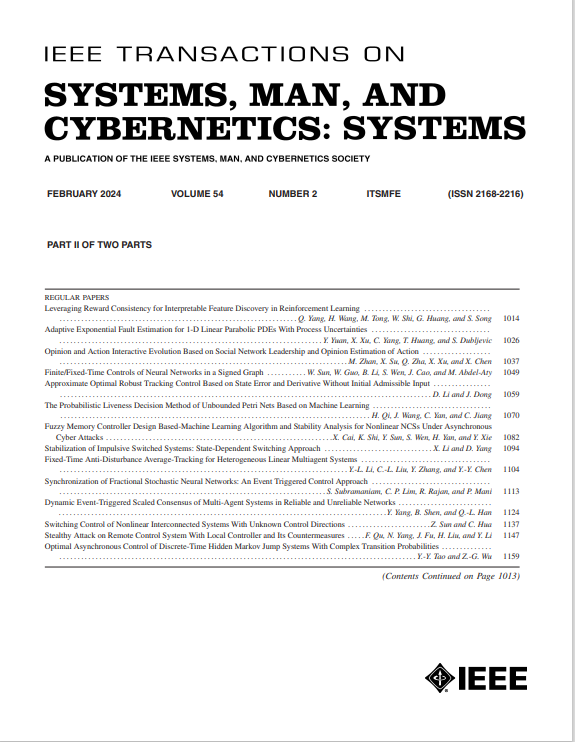基于平滑和矩阵分解的堆叠双向GRU模型用于机器停机时间预测
IF 8.7
1区 计算机科学
Q1 AUTOMATION & CONTROL SYSTEMS
IEEE Transactions on Systems Man Cybernetics-Systems
Pub Date : 2025-07-15
DOI:10.1109/TSMC.2025.3582768
引用次数: 0
摘要
在常规生产过程中,由于隐性干扰(RecDs)引起的机器停机(MDT_RP)会造成巨大的经济损失,降低生产速度。在现代工业中,状态监测、预测和维护策略被广泛应用于减少显性干扰(DomDs)引起的机器故障。然而,由于RecD, MDT_RP很少被探索。RecD多变量时间序列数据面临信息变化的挑战,其中包含大量噪声和异常数据点,使得序列方法难以准确预测MDT_RP。为了解决这一差距,提出了一种新的基于平滑和矩阵分解(MD)的堆叠双向门控循环单元(STMD_SBiGRU)用于MDT_RP预测。现有短信的缺点是受噪声数据的影响较大,严重影响了短信的特征信息提取能力。产生的误差在前向传播过程中被放大,从而干扰参数的优化。所提出的STMD_SBiGRU具有通过使用各种MD方法捕获数据集中的最大方差,以及通过应用各种平滑因子减少异常的优点。这种将MD和平滑相结合的双重创新使得模型中参数在多个堆叠层和方向上有效分布,从而避免了传统SMs的复杂性和过拟合问题,同时提高了网络的泛化性能。大量的实验工作表明,与其他数据驱动方法相比,STMD_SBiGRU可以更好地预测MDT_RP,并且对噪声数据具有很高的鲁棒性。本文章由计算机程序翻译,如有差异,请以英文原文为准。
Smoothing and Matrix Decomposition-Based Stacked Bidirectional GRU Model for Machine Downtime Forecasting
The machine downtime occurring during routine production (MDT_RP) because of recessive disturbances (RecDs) can cause huge economic losses and slow down production. In modern industries, condition monitoring, prognosis, and maintenance policies are widely applied to minimize machine failures caused by dominant disturbances (DomDs). However, MDT_RP, because of RecD, has rarely been explored. RecD multivariate time series data faces the challenge of changing information with many noisy and abnormal data points, making it difficult for sequential methods (SMs) to forecast MDT_RP accurately. To address this gap, a novel smoothing and matrix decomposition (MD) based stacked bidirectional gated recurrent unit (STMD_SBiGRU) is proposed for MDT_RP forecasting. Existing SMs have disadvantages in that they are highly affected by noisy data, which significantly affects their feature information extraction capability. The generated error gets amplified during forward propagation, thus interfering with the parameter’s optimization. The proposed STMD_SBiGRU has the advantage of capturing the maximum variance in the dataset by using various MD methods, as well as reducing abnormalities by applying various smoothing factors. This dual innovation of integrating MD and smoothing facilitates the effective distribution of parameters across multiple stacked layers and directions in a proposed model, thus avoiding complexity and overfitting problems of conventional SMs while improving network generalization performance. The extensive experimental work demonstrates that STMD_SBiGRU can forecast MDT_RP with better performance and is highly robust to noisy data compared to other data-driven methods.
求助全文
通过发布文献求助,成功后即可免费获取论文全文。
去求助
来源期刊

IEEE Transactions on Systems Man Cybernetics-Systems
AUTOMATION & CONTROL SYSTEMS-COMPUTER SCIENCE, CYBERNETICS
CiteScore
18.50
自引率
11.50%
发文量
812
审稿时长
6 months
期刊介绍:
The IEEE Transactions on Systems, Man, and Cybernetics: Systems encompasses the fields of systems engineering, covering issue formulation, analysis, and modeling throughout the systems engineering lifecycle phases. It addresses decision-making, issue interpretation, systems management, processes, and various methods such as optimization, modeling, and simulation in the development and deployment of large systems.
 求助内容:
求助内容: 应助结果提醒方式:
应助结果提醒方式:


